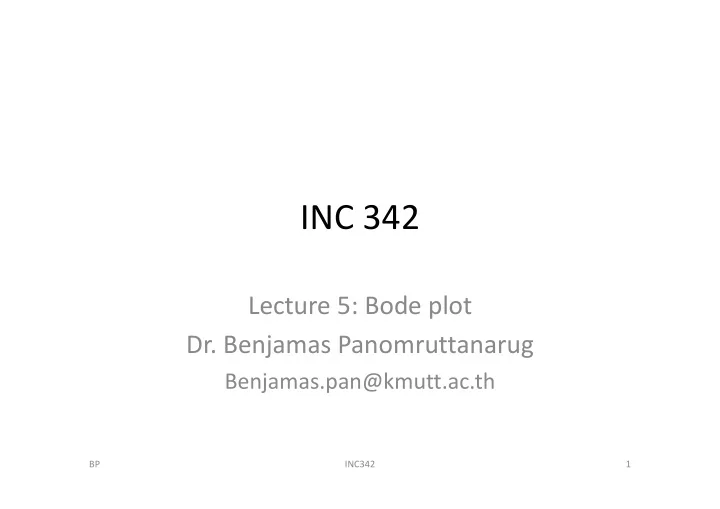

INC 342 Lecture 5: Bode plot Dr. Benjamas Panomruttanarug Benjamas.pan@kmutt.ac.th BP INC342 1
3 expressions of sinusoidal signal cos( ) sin( ) Starts from a sinusoidal signal, , which A t B t can be 2 2 1 cos tan ( / ) rewritten as A B t B A • Polar form (showing magnitude and phase shift): M i i 2 2 M A B i tan 1 ( / ) B A i BP INC342 2
2 expressions of sinusoidal signal (cont.) A • Rectangular form (complex number): jB cos( ) cos( ) cos( ) sin( ) sin( ) t t t cos( ) cos( ) cos( ) sin( ) sin( ) M t M t M t i i i i i i A B • Euler’s formula (exponential): j M i e i BP INC342 3
Frequency response of system ( • Magnitude response: ) M – ratio of output mag. To input mag. ( ) • Phase response: – difference in output phase angle and input phase angle • Frequency response: ( ) ( ) M BP INC342 4
Basic property of frequency Response ‘mechanical system’ input = force output = distance sinusoidal input gives sinusoidal output with same damped ( ) frequency ( ) shifted by , mag. expanded by ( ) M BP INC342 5
The HP 35670A Dynamic Signal Analyzer obtains frequency response data from a physical system. BP INC342 6
Finding frequency response from differential equation • Get transfer function ( s ) T s • Set j • Write ( ) ( ) M T s ( ) ( ) T s • Then the output is composed of ( ) ( ) ( ) M M M o i ( ) ( ) ( ) o i ( ) ( ) ( ) ( ) [ ( ) ( )] M M M o o i i BP INC342 7
Finding frequency response from transfer function s j 1 Substitute with ( ) G s ( 2 ) s 1 1 ( ) G j ( 2 ) ( 2 ) j j 0.5 ∟0 ω = 0, G = 0.5 ω = 2, G = 0.25 – j0.25 0.35 ∟‐ 45 ω = 5, G = 0.07 ‐ 0.17i 0.19 ∟‐ 68.2 ω = 10, G =0.019 ‐ j0.096 0.01 ∟‐ 78.7 ω = ∞ , G = 0 0 ∟‐ 90 BP INC342 8
What’s next? After getting magnitude and phase of the system, we need to plot them but how??? BP INC342 9
Types of frequency response plots • Polar plot (Nyquist plot): real and imaginary part of open ‐ loop system. • Bode plot : magnitude and phase of open ‐ loop system (begin with this one!!). • Nichols chart : magnitude and phase of open ‐ loop system in a different manner (not covered in the class). BP INC342 10
1 s ( ) Polar plot of G s ( 2 ) so called ‘Nyquist plot’ BP INC342 11
Bode plot Magnitude Phase Note: log frequency and log magnitude BP INC342 12
1 What about ??? ( ) G s ( 2 )( 3 ) s s • plot each term separately and sum them up • log magnitude (s+2) added with log magnitude (s+3) It’s convenient for calculation to plot magnitude in log scale!!! • phase (s+2) added with phase (s+3) BP INC342 13
Example ( 3 ) s ( ) sketch bode plot of G s ( 1 )( 2 ) s s s break frequency at 1,2,3 BP INC342 14
Example ( 3 ) s sketch bode plot of ( ) G s 2 ( 2 )( 2 25 ) s s s s j • Set then ( 3 ) j ( ) G j 2 (( ) 2 )(( ) 2 ( ) 25 ) j j j 3 • At DC, set s=0, ( 0 ) G 50 • Break frequency at 2, 3, (or 5) 25 BP INC342 15
Conclusions Drawing Bode plot • Get transfer function ( s ) T s • Set j • Evaluate the break frequency • Approximate mag. and phase at low and high frequencies, and also at the break frequency for 1 st order, 20 dB / – Mag. plot: slope changes dec for 2 nd order (at break frequency) 40 dB / dec – Phase plot: slope changes for 1 st order, 45 / dec for 2 nd order 90 / dec BP INC342 16
Recommend
More recommend